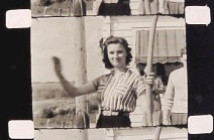When you see old film clips from home movies (or news broadcasts, or feature films or anything else) incorporated in TV commercials or documentaries or comedy programs etc. the film makers often will have had to “license” the old footage from the copyright holder, or in the case of public domain material, from an archive that has access to quality prints or transfers of the material. Providers of such footage charge a per-second fee for their services, often on a sliding scale depending on the commercial purpose of the project and the scope and method of its transmission to the public. A good illustrative example is the schedule of fees employed by Northeast Historic Film.
Can you earn money for stock footage use of your films? Possibly, but probably not on your own. Assuming your home movies would be perfect for some film project somewhere, there is the enormous hurdle of connecting that producer with your footage. Stock footage companies and certain archives do exactly that, acting as a centralized destination for film makers seeking out particular subject matter. Such organizations must dedicate substantial resources not only to transfer and storage technology to hold the moving images, but to cataloguing and describing the footage so it can be easily searched, and providing a system for film makers to preview and select material.
You may encounter film transfer services that offer free transfer work in exchange for the rights to incorporate your footage in their own documentary projects or in their stock footage libraries. Typically, you will be asked to sign over the rights to your footage to the transfer house so that they can use the footage in their own projects or sell clips from your films in turn to other parties looking for footage of a certain kind for their work. Often, the saved expense of having the films transferred would make this sort of arrangement worthwhile. But keep in mind that if you sign over broad rights to your films, you may have no grounds to complain if your footage is used in ways that distort the original context, or that present your loved ones in unflattering terms. The various individuals appearing in your films would retain privacy rights that might provide a grounds for contesting uses they find objectionable, but if you get to the point of hiring lawyers to settle the problem, you will wish you had simply paid cash for your transfers.
In discussing options with various organizations, make a point of learning about their goals. Is this a commercial operation making a living by transferring films and profiting from footage sales, or is it perhaps a non-profit 501(c)(3) entity with a stated and demonstrated mission of preserving history for the public good?
For additional information about how the cash value of moving images may be calculated, you may wish to consult Sam Kula’s book Appraising Moving Images: Assessing the archival and monetary value of film and video records (2002, Scarecrow Press).

